

Link layer. Despite the different semantics of layering in TCP/IP and OSI, the link layer is sometimes described as a combination of the data link layer (layer 2) and the physical layer (layer 1) in the OSI model.
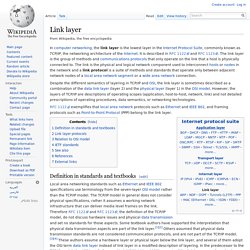
However, the layers of TCP/IP are descriptions of operating scopes (application, host-to-host, network, link) and not detailed prescriptions of operating procedures, data semantics, or networking technologies. Data link layer. Examples of data link protocols are Ethernet for local area networks (multi-node), the Point-to-Point Protocol (PPP), HDLC and ADCCP for point-to-point (dual-node) connections.
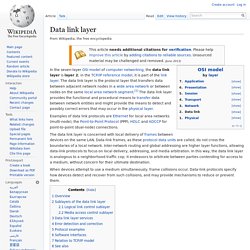
When devices attempt to use a medium simultaneously, frame collisions occur. Data-link protocols specify how devices detect and recover from such collisions, and may provide mechanisms to reduce or prevent them. Overview[edit] Layer 2 devices deliver frames using unique hardware addresses. A frame's header contains source and destination addresses that indicate which device originated the frame and which device is expected to receive and process it. Link Access Procedure for Frame Relay. In wide area network computing, Link Access Procedure for Frame Relay (or LAPF) is part of the network's communications protocol which ensures that frames are error free and executed in the right sequence.
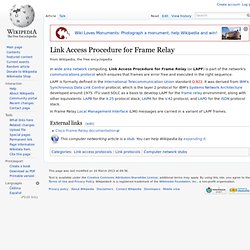
LAPF is formally defined in the International Telecommunication Union standard Q.922. It was derived from IBM's Synchronous Data Link Control protocol, which is the layer 2 protocol for IBM's Systems Network Architecture developed around 1975. Link Access Procedures, D channel. In Integrated Services Digital Network (ISDN) telecommunications, Link Access Protocol, D channel is part of the network's communications protocol which ensures that messages are error free and executed in the right sequence.

LAPB. Link Access Procedure, Balanced (LAPB) implements the data link layer as defined in the X.25 protocol suite.
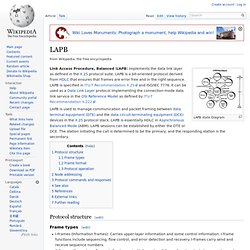
LAPB is a bit-oriented protocol derived from HDLC that ensures that frames are error free and in the right sequence. X.25. X.25 network diagram.
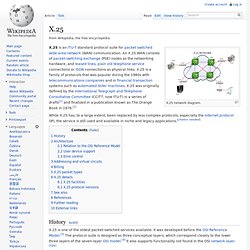
X.25 is an ITU-T standard protocol suite for packet switched wide area network (WAN) communication. An X.25 WAN consists of packet-switching exchange (PSE) nodes as the networking hardware, and leased lines, plain old telephone service connections or ISDN connections as physical links. X.25 is a family of protocols that was popular during the 1980s with telecommunications companies and in financial transaction systems such as automated teller machines.
X.25 was originally defined by the International Telegraph and Telephone Consultative Committee (CCITT, now ITU-T) in a series of drafts[1] and finalized in a publication known as The Orange Book in 1976.[2] While X.25 has, to a large extent, been replaced by less complex protocols, especially the Internet protocol (IP), the service is still used and available in niche and legacy applications. Point-to-Point Protocol. PPP is used over many types of physical networks including serial cable, phone line, trunk line, cellular telephone, specialized radio links, and fiber optic links such as SONET.
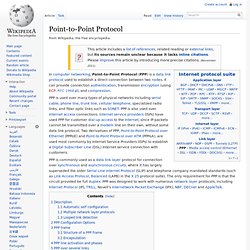
PPP is also used over Internet access connections. Internet service providers (ISPs) have used PPP for customer dial-up access to the Internet, since IP packets cannot be transmitted over a modem line on their own, without some data link protocol. G.hn. G.hn is the common name for a home network technology family of standards developed under the International Telecommunication Union's Telecommunication Standardization sector (the ITU-T) and promoted by the HomeGrid Forum[1] and several other organizations.[2] The G.hn specifications define networking over power lines, phone lines and coaxial cables with data rates up to 1 Gbit/s.[3] ITU-T Recommendation (the ITU's term for standard) G.9960, which received approval on October 9, 2009,[4] specified the physical layers and the architecture of G.hn.
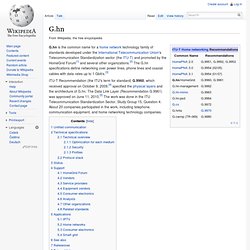
The Data Link Layer (Recommendation G.9961) was approved on June 11, 2010.[5] The work was done in the ITU Telecommunication Standardization Sector, Study Group 15, Question 4. About 20 companies participated in the work, including telephone, communication equipment, and home networking technology companies. Unified communication[edit] Frame Relay. A basic frame relay network Frame relay is a standardized wide area network technology that specifies the physical and logical link layers of digital telecommunications channels using a packet switching methodology.
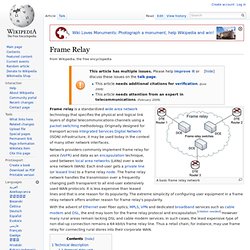
Originally designed for transport across Integrated Services Digital Network (ISDN) infrastructure, it may be used today in the context of many other network interfaces. With the advent of Ethernet over fiber optics, MPLS, VPN and dedicated broadband services such as cable modem and DSL, the end may loom for the frame relay protocol and encapsulation. [citation needed] However many rural areas remain lacking DSL and cable modem services. In such cases, the least expensive type of non-dial-up connection remains a 64-kbit/s frame relay line. Technical description[edit] An enterprise can select a level of service quality — prioritizing some frames and making others less important. IEEE 802.3. 802.3 is a technology that supports the IEEE 802.1 network architecture.
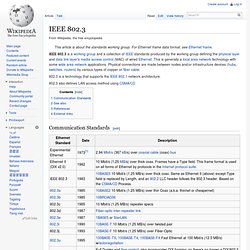
Layer 2 Tunneling Protocol. In computer networking, Layer 2 Tunneling Protocol (L2TP) is a tunneling protocol used to support virtual private networks (VPNs) or as part of the delivery of services by ISPs. It does not provide any encryption or confidentiality by itself. Rather, it relies on an encryption protocol that it passes within the tunnel to provide privacy.[1] Media access control. Functions performed in the MAC sublayer[edit] According to IEEE Std 802-2001 section 6.2.3 "MAC sublayer", the primary functions performed by the MAC layer are:[1] Frame delimiting and recognitionAddressing of destination stations (both as individual stations and as groups of stations)Conveyance of source-station addressing informationTransparent data transfer of LLC PDUs, or of equivalent information in the Ethernet sublayerProtection against errors, generally by means of generating and checking frame check sequencesControl of access to the physical transmission medium In the case of Ethernet, according to 802.3-2002 section 4.1.4, the functions required of a MAC are:[2] receive/transmit normal frameshalf-duplex retransmission and backoff functionsappend/check FCS (frame check sequence)interframe gap enforcementdiscard malformed framesappend(tx)/remove(rx) preamble, SFD (start frame delimiter), and paddinghalf-duplex compatibility: append(tx)/remove(rx) MAC address See also[edit]
1 & 2. IPS Link Layer (Internet Protocol Suite) Logical link control. IEEE 802.2. IEEE 802.2 is the name given to a subsection of the IEEE 802 standard that describes a software component of a computer network. It defines Logical Link Control (LLC), which is the upper portion of the data link layer of the OSI Model. The LLC sublayer presents a uniform interface to the user of the data link service, usually the network layer. Beneath the LLC sublayer is the Media Access Control (MAC) sublayer, which is dependent on the particular medium being used (Ethernet, token ring, FDDI, 802.11, etc.). Parallel Line Internet Protocol. The Parallel Line Internet Protocol provides Link Layer services for the Internet Protocol, the protocol used for forming small local area networks and large computer networks, such as the Internet, enabling computers without standard dedicated networking hardware, such as Ethernet, but with older parallel port devices, to communicate.
Operation[edit] The Internet Protocol Suite is the standards-based networking model and software specification for forming small and large computer networks, from local area networks to global communication systems, such as the Internet. It is usually implemented by software and hardware features that use Ethernet network interface cards, cabling, and networking switches or hubs. Early personal computers did not have Ethernet hardware included in their design and bus adapters were initially expensive. A solution to was to use the, at the time, standard parallel port, typically used for connection to a printer or similar output device. Generic Framing Procedure. Serial Line Internet Protocol. Description[edit] SLIP modifies a standard TCP/IP datagram by.
Serial Line Internet Protocol. High-Level Data Link Control. Synchronous Data Link Control. IS-IS. Intermediate System to Intermediate System (IS-IS) is a routing protocol designed to move information efficiently within a computer network, a group of physically connected computers or similar devices. It accomplishes this by determining the best route for datagrams through a packet-switched network. The protocol was defined in ISO/IEC 10589:2002 as an international standard within the Open Systems Interconnection (OSI) reference design. Address Resolution Protocol.
Asynchronous Transfer Mode. IBM Turboways ATM 155 PCI network interface card Marconi ForeRunnerLE 25 ATM PCI network interface card.